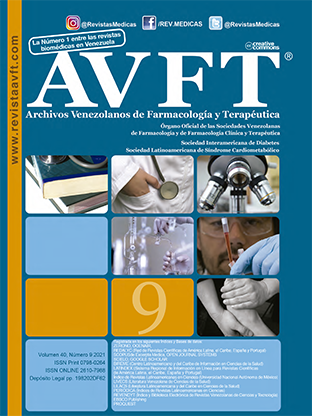Assessment of factors associated with patient safety in the intensive care unit
Keywords:
: Patient Safety; Intensive care unit; Adverse Events, Work StressAbstract
Introduction: The set of processes, elements and instruments and methodologies based on medical evidence that considerably reduce the risk of the patient suffering an adverse event (AE) of any kind or, failing that, reduce its impact, is called safety of the patient. Patient.
Objective: Identify the factors that affect safety in intensive care services, a relevant indicator of the quality of health care
Methodology: Descriptive, cross-sectional study. Four basic aspects that impact patient safety were reviewed. The prognosis of the patients was evaluated with APACHE II and the need for attention by the TISS score, Adherence to Guidelines, Patient Safety Culture and Perception of Workload. The qualitative variables are summarized through absolute and percentage frequencies. The magnitude of the association between APACHE II and TISS Score was made through χ².
Results: 27 (29.6%) Nurses (ENF) and 64 (70.3%) Certified Nursing Assistants were evaluated. The patients had an APACHE II of 25.9 ± 5.5pts (IQR 23 - 29pts) and a TISS of 24 ± 12.9pts (IQR 14 - 31), with no direct relationship between these two evaluation parameters (χ²: 14.4; p- value: 0.7006). There was a high level of compliance with the Guidelines over 90% and a great capacity for teamwork, also greater than 90%. Both NFS and ACEs demonstrated evidence-based knowledge of their procedures. The most prevalent risk factor was work stress (60.44%) and that this prevented people from resting correctly.
Conclusions: The most important aspect was work stress, which had a negative impact on all aspects of the life of health personnel.
Downloads
References
Ministerio de la Protección Social. Lineamientos para la implementación de la Política de Seguridad del Paciente. Ministerio de la Protección Social, editor. Bogotá (Col): Diseño e Impresión Buenos y Creativos; 2008. 52 p.
Cometto MC, Gómez PF, Marcon Dal Sasso GT, Zárate-Grajales RA, DeBortoli-Cassiani SH, Morales CF. Enfermería y seguridad de los pacientes. Organización Mundial de Salud, editor. Organización Panamericana de la Salud; 2011.
Organización Mundial de la Salud. Calidad de la atención: seguridad del paciente: informe de la Secretaría. 2002.
Sanmartín Artiñano L. Sistema de notificación y aprendizaje para la seguridad del paciente en cuidados intensivos : estrategias y actuaciones [Internet]. 2013. Available from: http://hdl.handle.net/10902/3947
García Díez R. Construyendo seguridad en cuidados intensivos. Enfermería Intensiva [Internet]. 2011 Jan;22(1):1–2. Available from: https://linkinghub.elsevier.com/retrieve/pii/S1130239911000162
Ceballos Ramírez LM, Rodríguez Ramírez DM. Cuidados de enfermeria en UCI al paciente con reposo prolongado susceptible a desacondicionamiento cardiovascular. Universidad de Antioquia; 2010.
Organización Mundial de la Salud / Organización Panamericana de la Salud. IBEAS: red pionera en la seguridad del paciente en Latinoamérica. 2010. 16 p.
Parra DI, Camargo-Figuera FA, Rey Gómez R. Adverse events arising from nursing care: phlebitis, pressure ulcers and falls. Enfermería Glob [Internet]. 2012;11(28):159–69. Available from: http://scielo.isciii.es/scielo.php?script=sci_arttext&pid=S1695-61412012000400010&lng=es&nrm=iso&tlng=es
Knaus WA, Draper EA, Wagner DP, Zimmerman JE. APACHE II: a severity of disease classification system. Crit Care Med [Internet]. 1985 Oct;13(10):818–29. Available from: http://www.ncbi.nlm.nih.gov/pubmed/3928249
Kaufmann I, Briegel J. Therapeutic Intervention Scoring System (TISS) - a method for calculating costs in the intensive care unit (ICU) and intermediate care unit (IMCU). Crit Care [Internet]. 2000;4(Suppl 1):P243. Available from: http://ccforum.biomedcentral.com/articles/10.1186/cc962
Cassiani S, Hoyos MC, Barreto M, Sives K, da Silva FA. Distribución de la fuerza de trabajo en enfermería en la Región de las Américas. Rev Panam Salud Pública [Internet]. 2018;1–10. Available from: http://iris.paho.org/xmlui/handle/123456789/34993
Borrero Ortiz ZP, Bueno Barajas PA, Orduz Barón A, Rodríguez Parada MA. Carga laboral en el personal de enfermería en la Unidad de cuidado intensivo. [Internet]. Universidad Cooperativa de Colombia; 2018. Available from: https://repository.ucc.edu.co/bitstream/20.500.12494/17012/6/2019_carga_laboral_en_el_personal_de_enfermeria_en_la_unidad_de_cuidado_intensivo..pdf
Ministerio de la Protección Social. Guía Buenas Practicas Seguridad del Paciente. INCONTEC, editor. 2010. 48 p.
Saltos-Rivas M, Pérez-Cardoso CN, Suárez-Mella R, Linares-Giler SM. Análisis de la carga laboral del personal de enfermería, según gravedad del paciente | Analysis of the workload of nursing staff, according to the severity of the patient. Rev Cubana Enferm [Internet]. 2018;34(2). Available from: http://www.revenfermeria.sld.cu/index.php/enf/article/view/2170/366
Bacon CT, Hughes LC, Mark BA. Organizational influences on patient perceptions of symptom management. Res Nurs Health [Internet]. 2009 Jun;32(3):321–34. Available from: http://www.ncbi.nlm.nih.gov/pubmed/19204940
Achury Saldaña DM, Achury Beltrán LF, Díaz Alvarez JC, Rodríguez Colmenares SM, Alvarado HR, Ortiz C, et al. Panorama General de la Relación Enfermera-Paciente en Algunas Unidades de Cuidado Intensivo en Bogotá. Investig en Enfermería Imagen y Desarro [Internet]. 2014 Jul 16;16(1). Available from: http://revistas.javeriana.edu.co/index.php/imagenydesarrollo/article/view/6856
Neuraz A, Guérin C, Payet C, Polazzi S, Aubrun F, Dailler F, et al. Patient Mortality Is Associated With Staff Resources and Workload in the ICU: A Multicenter Observational Study. Crit Care Med [Internet]. 2015 Aug;43(8):1587–94. Available from: http://www.ncbi.nlm.nih.gov/pubmed/25867907
Lin C-C, Shih C-L, Liao H-H, Wung CHY. Learning from Taiwan patient-safety reporting system. Int J Med Inform [Internet]. 2012 Dec;81(12):834–41. Available from: http://www.ncbi.nlm.nih.gov/pubmed/22999224
Magalhães AMM de, Costa DG da, Riboldi C de O, Mergen T, Barbosa A da S, Moura GMSS de. Association between workload of the nursing staff and patient safety outcomes. Rev Esc Enferm USP [Internet]. 51:e03255. Available from: http://www.ncbi.nlm.nih.gov/pubmed/29211232
Liu L-F, Lee S, Chia P-F, Chi S-C, Yin Y-C. Exploring the association between nurse workload and nurse-sensitive patient safety outcome indicators. J Nurs Res [Internet]. 2012 Dec;20(4):300–9. Available from: http://www.ncbi.nlm.nih.gov/pubmed/23154441
Downloads
Published
How to Cite
Issue
Section
License
Copyright (c) 2023 AVFT – Archivos Venezolanos de Farmacología y Terapéutica

This work is licensed under a Creative Commons Attribution-NonCommercial-NoDerivatives 4.0 International License.




